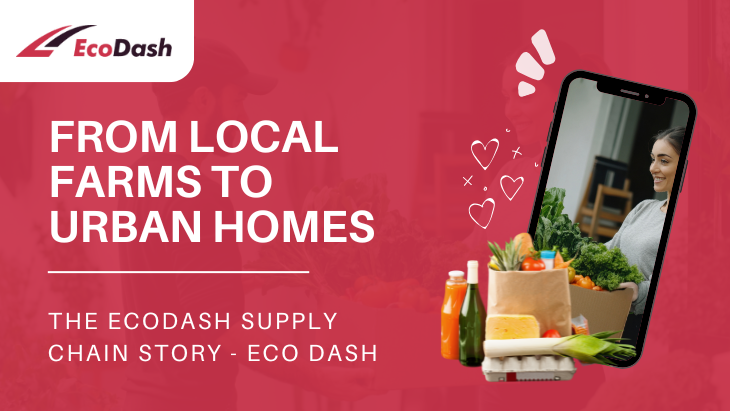Convenience is a lifestyle in the age of fast digitalization. It takes only a few taps on our smartphones to have whatever we want delivered to us, be it groceries and clothes, electronics, or even dinner. Worldwide, Grocery Delivery in Canada has experienced a huge popularity boost, particularly following the pandemic that altered the shopping habits of individuals.
It is, however, when we adopt the convenience of doors that this question comes up: How green is your daily delivery? In the background of the convenience and rapidity of the contemporary delivery service lies an environmental price, the wastage of packaging, the release of carbon dioxide, and the lack of an efficient route to the consumer. The silver lining is that the combination of businesses, consumers, and technology can ensure a greener and more sustainable routine.
We should look at the environmental effect of day-to-day deliveries and how we can all help to lower the environmental cost, without compromising the convenience.
The Underground Environmental Price of Convenience.
On clicking the Buy Now button, you overlook the path that the commodity will follow before it arrives at your door. Every delivery is usually characterized by a number of procedures: packaging, warehousing, transportation, and final-mile delivery. All these phases come with carbon emissions, energy consumption, and waste.
The University of California study discovered that the total delivery emissions could be more than half of the last-mile delivery, the last stage of delivering what is in the warehouse to your door. This impact can be even more significant in such a country as Canada, where centralized urban and rural areas are distributed.
In the case of Grocery Delivery in Canada, it implies that small and frequent orders, same-day delivery, and non-optimized delivery routes can easily contribute to a huge carbon footprint. The issue is to find the balance between the convenience of customers and the responsibility to the environment.
The Rise of Grocery Delivery in Canada: A Two-Sided Sword.
Grocery delivery through the internet has transformed the shopping habits of Canadians. Recent reports indicate that close to 60 percent of Canadians have been using online grocery delivery or pickup services at least once. Firms such as Instacart, PC Express, Walmart, and Sobeys have simply made it easier than ever to complete your pantry without going outside.
Although this tendency is time-saving and results in fewer personal visits to the store (a good quality of the planet), in addition, it may lead to an increased number of delivery vehicles on the roads, which operate below their capacity or use inefficient routes. This adds to the emission of greenhouse gases and urban congestion.
It does not mean to give up convenience, but to reconsider its utilization.
Smarter Systems of Delivery Can Change Things
* Technology is an important factor in ensuring that Grocery Delivery in Canada is eco-friendly. Most firms are investing in:
* Optimization of routes in order to reduce the travel distance and fuel consumption.
* Electric delivery vehicles (EVs) lower carbon emissions.
Orders that are delivered in batches and are clustered in the same location.
To illustrate, certain Canadian grocery stores have initiated the use of AI-driven logistics systems that automatically calculate efficient routes without having to make unnecessary trips. Not only does this reduce both emissions and cut operational costs, but it is also a win-win for the businesses and the planet.
Packaging: The Silent Polluter.
Packaging waste is one of the largest environmental problems in delivery services. A single box, a plastic bag, or a bubble wrap all contribute to the heap of single-use waste, which will eventually go to landfills.
The Grocery Delivery in Canada case makes the issue more complicated because of the sensitivity of the goods, such as dairy, meat, and frozen foods, to temperature changes, which necessitate the use of ice packs and insulated containers. On the one hand, they preserve groceries, but on the other hand, they raise wastage.
To combat this, environmentally conscious firms are:
* Packaging in recyclable or compostable materials.
* It should provide reusable delivery bags and containers.
* Motivate customers to send back packaging materials so that they can be reused.
With in-store choices, a consumer can make a difference by visiting stores that use sustainable packaging or finding stores offering minimal packaging as an alternative.
Delivery Frequency: Less Is More.
One is tempted to purchase small grocery batches daily during the week in order to be as fresh as possible. Nonetheless, with frequent deliveries, there are increased movements - and increased emissions.
Bringing together your orders can be of great environmental impact. As an illustration, transportation emissions can be decreased by close to 60 percent by the introduction of one large grocery delivery a week rather than three small ones
Certain online grocery stores in Canada can now provide so-called green delivery slots, allowing the purchaser to select a time frame when the delivery vehicles are already planned to be in their area. Such a system will help save on unnecessary trips and not decrease the quality of services.
Delivery Vehicles: Electric and Sustainable.
Grocery Delivery in Canada has a future that has been electric. Large organizations in the logistics sector and retailing are switching to electric vans and bikes to reduce emissions.
There are grocery delivery workers who are already riding on electric cargo bikes in such cities as Toronto and Vancouver, primarily along short routes. Such alternatives minimize pollution, as well as relieve congestion in busy cities.
Incentives issued by the government in electric vehicles (EVs) and charging infrastructure are contributing towards this transition, which preconditions a cleaner and greener delivery network.
Consumer Awareness: The strength of Conscious Decisions.
The shift towards environmentally friendly delivery is not completely within the control of corporations, but consumers also contribute to it equally. Each buying judgment sends a message of what sort of future we are favoring.
These are just effective measures that you can take to make your Grocery Delivery in Canada routine more sustainable:
* Picture yourself ahead : Bundle orders to minimize numerous deliveries.
* Use slower shipping : Fast shipping tends to have adverse effects on environmental pollution by way of hasty logistics.
* Favour environmentally-friendly brands: Select those companies that focus on sustainable operations.
* Return or recycle packaging: Some of the services will now take used bags or boxes back in order to use them again.
Efforts to cut down on your carbon footprint through simple changes in behavior can save you a lot of carbon in the long run.
Local and Farm-to-Door Deliveries Local and Farm-to-Door Deliveries.
Local food suppliers may also be supported. The purchasing of goods at regional farms or local grocery chains would minimize the distance that the goods have to travel, and this directly decreases emissions.
Most Grocery Delivery in Canada now collaborates with local farmers and manufacturers, delivering fresh and seasonal foods that do not necessarily need to travel a long distance around the country. This not only contributes to sustainability but also builds up local economies.
The Future: Artificial Intelligence, Robotization, and Green Innovation.
With sustainability being one of the main concerns, innovation keeps transforming the world of delivery. The future of delivery may be fast and eco-friendly with AI-driven predictive demand systems minimizing overstocking, autonomous delivery by electric vehicles and drones, and so on.
Companies in Canada, both small start-ups and large retailers, are trying out such technologies, hoping to create a future where convenience and sustainability are two sides of the same coin.
Conclusion
Comfort does not necessarily have to be at the cost of the planet. Through reconsidering our ordering, delivering, and consuming, we will be able to transform our daily habits into sustainable ones.
The innovation of Grocery Delivery in Canada is evidence that innovation is capable of changing the way of life. EcoDash However, along with innovation should be responsibility - through route optimization and packaging, as well as the sponsorship of electric fleets and local manufacturers.
Finally, an environmentally-friendly delivery process starts with a conscious decision of the companies and consumers. The next time you order now, keep in mind that each little green thing makes a great difference on the planet.


 Cart
Cart







Leave a reply